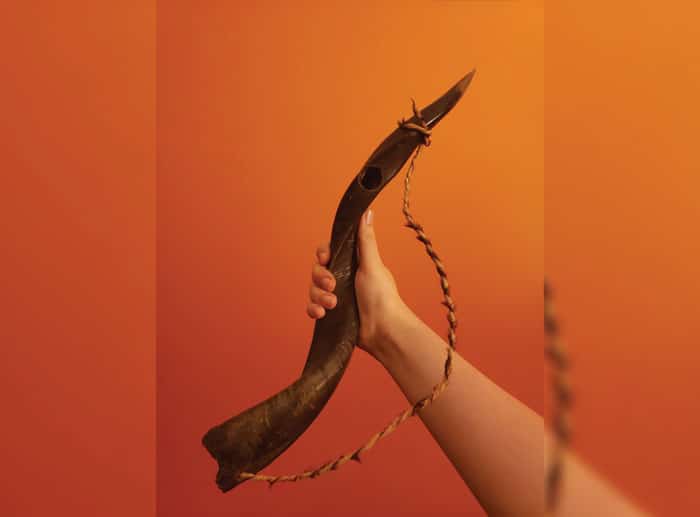
When we comment on the physical rituals of our tradition, it’s usually to discuss what they symbolize. Whether it’s a mezuzah, tallit, succah, Kiddush cup, Hannukah candle or an elaborate Seder table, we give meaning to these rituals by asking ourselves what they represent. In that sense, physical rituals help ground our tradition.
Of all these concrete rituals, perhaps the quirkiest is the shofar, the ram’s horn we blow on Rosh Hashanah and Yom Kippur.
We’ve all heard rabbis wax eloquently about the rich symbolism of the shofar. You probably heard it yourself during Rosh Hashanah. Few rituals, in fact, are more laden with meaning. On MyJewishlearning.com you’ll see 10 symbols or ideas associated with the shofar:
- Reminiscent of the Coronation of a King
- Stirs Our Conscience
- Reminds Us of Sinai Revelation
- Like the Exhortations of the Prophets
- Reminder of the Temple’s Destruction
- Symbol of the Ram That Abraham Sacrificed
- Summons Us to Feeling Humility
- Reminder of Judgment Day
- Foreshadows Return from Exile
- Foreshadows Coming of the Messiah
This is why I did a double take the other day when I heard a rabbi talk about the shofar not as a symbol — but as something we can become.
“Be a shofar,” he said.
It was Rabbi Abraham Cooper of the Simon Wiesenthal Center (SWC), who was speaking at a “Multifaith Unity Program” at the Museum of Tolerance. The event, co-sponsored by SWC and the Muslim Coalition for America (MCA), featured Christian, Muslim and Jewish speakers who gathered for the official signing ceremony of a United States Multifaith Unity Statement.
Near the end of the program, Rabbi Cooper was in conversation with Omar Qudrat, founder of MCA, when the moderator asked a question that occupies the minds of most activists and change agents: What can we do to move our cause forward?
In classic Jewish fashion, the rabbi told a story. He spoke of an event he had recently attended for Jewish World Watch (JWW), called “Global Soul,” that honored Nury Turkel, an activist-survivor of the atrocities against his fellow Uyghurs, who are persecuted because of their religion and ethnicity.
When Cooper gave Turkel a shofar as a tribute to his efforts, he told him, “You are the shofar.” That was his message to the audience at the Museum of Tolerance: The best thing one can do to move a cause forward is to “be a shofar.”
When Cooper gave Turkel a shofar as a tribute to his efforts, he told him, “You are the shofar.” That was his message to the audience at the Museum of Tolerance: The best thing one can do to move a cause forward is to “be a shofar.”
The sound of the shofar, he reminded us, suggests traits that are crucial to any activist, such as humility, authenticity and resilience.
The founder of JWW, the late, great Rabbi Harold Schulweis, lived his life as a shofar. Indeed, in its Rosh Hashanah message, JWW urges people to become shofars. It called Turkel a “shofar for his Uyghur sisters and brothers” and its honorees “shofars who have dedicated themselves to bringing help and healing to genocide and mass atrocity survivors.”
Becoming a shofar takes symbolism to another level. If the shofar becomes our voice, then we must own it. There is no longer any distance between us and the ritual. We become the instrument.
This instrument also suggests restraint. The late Chief Rabbi Jonathan Sacks describes hearing the shofar as something that can’t be put into words. He calls it “the wordless cry of the heart of a religion of words.”
In a world today where we are drowning in too many words, many of which are not just hurtful but trivial and triggering, the shofar, with its “wordless cry of the heart,” reminds us to select those words wisely.
In a world today where we are drowning in too many words, many of which are not just hurtful but trivial and triggering, the shofar, with its “wordless cry of the heart,” reminds us to select those words wisely.
If we become shofars, we have no choice but to speak humbly and carefully, and put actions before words.
We will hear the final shofar blast of the Holy Days at the conclusion of Yom Kippur, when many of us will be physically and spiritually drained and anxious to break our fasts.
As we hear that wordless cry, let’s aspire to become shofars, and move our causes and souls forward.























 More news and opinions than at a Shabbat dinner, right in your inbox.
More news and opinions than at a Shabbat dinner, right in your inbox.